I’m now officially represented by Foster/White Gallery. A new adventure.
Author Archives: Cameron
Fiber Sculpture Class
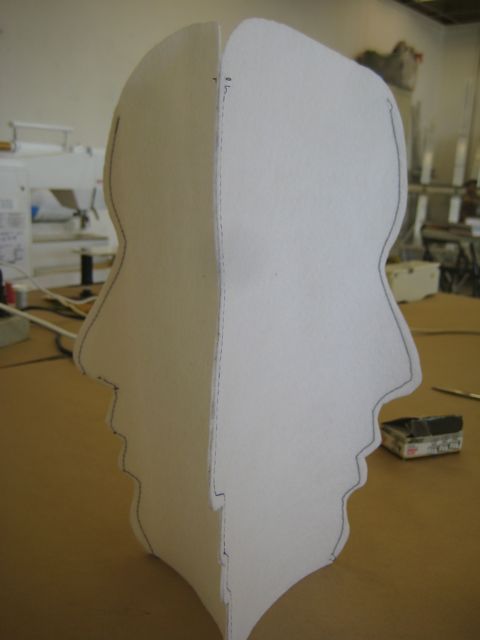
Therese's prototype
This last weekend I taught an intensive at Pratt Fine Arts Center, Fiber in Three Dimensions. I was nervous because, although I’ve taught plenty of technique classes, this felt different. I wasn’t sure if I would be able to teach how to see and design in three dimensions. I had a terrific group of artists to work with, each with their own vision, each willing to try something new.
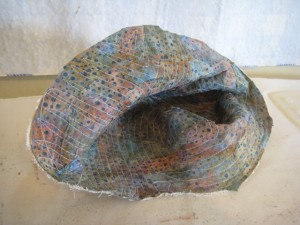
Susan's bowl
We started the first day with a slide show survey of fiber sculpture, beginning the conversation about designing in 3d and how to support your structure. Our first project, what I think of as a pinch pot, was a circle of fabric that we cut and overlapped to create dimension, adding structure through stitch. A very basic and simple technique, yet versatile and a good way to feel the transition between two- and three-dimensions and how quickly that can happen.
In the afternoon I showed a second slide show introducing my sculptural technique, a multipanelled piece using peltex as an inner layer to add structure. They started sketching their ideas with the plan of starting on patterning the next day.

Judy's piece
The next two days they spent drawing, patterning, and layering their pieces. Some people worked faster than others. As always, it would have been nice to have had more time to work. Only one person finished her piece, although she called said it was a prototype and had plans to embellish it further.
I felt it was a successful class, the samples all worked, the slide shows were helpful and well-received. Only one student had much experience with sewing, the others came from working in other media including jewelry and printmaking. Several of them were apprehensive about sewing at first but felt much more confident by the end of the weekend. One woman, a jeweller, had no confidence in her ability to sew and wasn’t sure she was going to stay. By the end of the class, she was talking about buying a sewing machine!
I’ll definitely teach this one again!
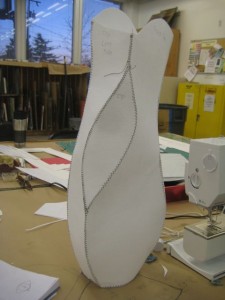
Susan's piece
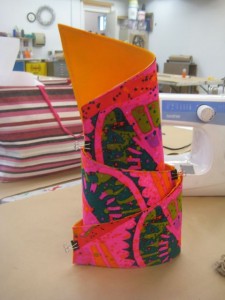
Lisa's piece
Stitched Shibori
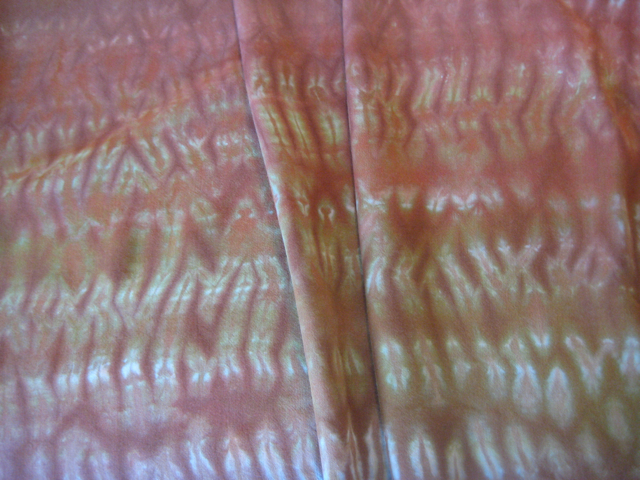
I had a little unstructured time at the studio recently and decided to try a hand-stitched shibori resist. I’ve never done this before because I don’t have much patience for hand-stitching. First thing I noticed, no big surprise, it took a long time to do the stitching. I kind of enjoyed it though, I listened to music and got into a bit of a meditative state.
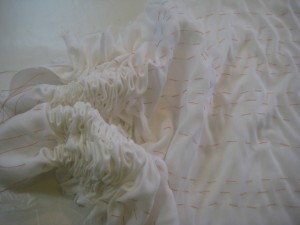 Here’s the piece, a length of white rayon, fully stitched and partially pulled taut for the resist. I wasn’t sure how well the resist would work because the fabric is somewhat loosely woven. One more thing to think about while putting in those hours of stitching!
Here’s the piece, a length of white rayon, fully stitched and partially pulled taut for the resist. I wasn’t sure how well the resist would work because the fabric is somewhat loosely woven. One more thing to think about while putting in those hours of stitching!
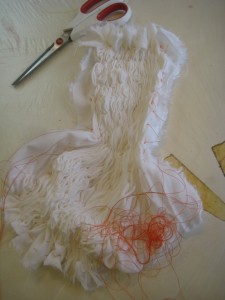
Here’s the piece ready for dyeing. After I pulled all the threads, I rethreaded each one and secured it on both sides of the piece while pulling taut. Again, all this time, I’m wondering if this is going to work at all.
I dyed the piece with Moss Green and Rust Brown procion mx dyes from Dharma Trading. I was a little disappointed by the color saturation of the dye on the finished piece. I dyed a few other pieces of rayon at the same time with the same results. I’m surprised because I’ve had really good results with rayon before.
Overall though, I’m happy with the piece. The stitching resist worked and looks pretty much like all the pictures in the books. My stitching is a little uneven, but it doesn’t really seem to matter. I like the look of it, very organic. Will I decide I like it enough to spend those hours hand-stitching? Hmmm, maybe I’ll try the machine stitched version first.
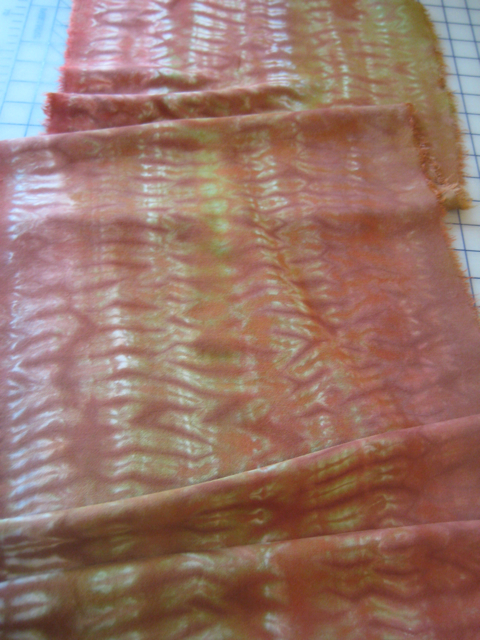
Now What?
Now that I’ve finished the work for the Foster White show and had time for a breather, there’s the perennial question, “Now what?” It’s not a comfortable place to be as an artist, but something that must be muddled through. I usually spend this time cleaning my studio (I even washed the floor!), looking at books and magazines, and mentally pacing. I pick things ups, I put them down, nothing seems to fit. It’s a good time to try new techniques and make messes, not sure of where I’m heading.
I have a new class at Pratt coming up, Fiber in Three-Dimensions, so that gives me some focus. I’m trying some other ways of working in 3-d, some other structural materials that have been sitting on the shelf. I’m also doing some research on other artists sculpting in fiber. I also picked up a book at the library, Transparency in Textiles by Dawn Thorne, that’s got me thinking about revealing the space within.
And so I continue, picking things up, putting them down, until the next big thing reveals itself to me.
Foster White Show
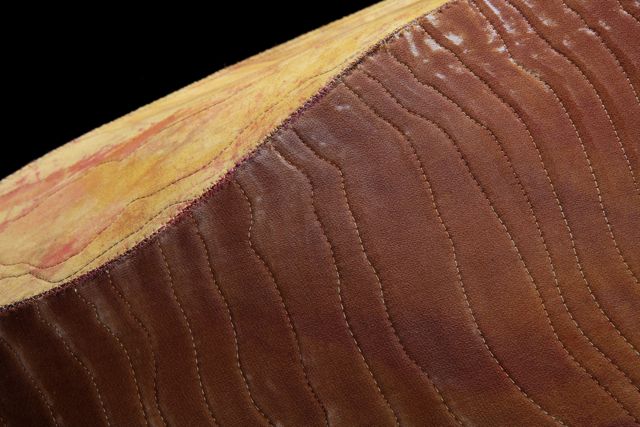
Shape clay into a vessel;
It is the space within that makes it useful.
–Tao Te Ching
Cameron Anne Mason’s work is informed by the exploration of surface design on fabric. Her fiber work explores the intersection of nature, civilization, and time. The Vessel Series references the nature of vessels as both useful and sacred objects.
Cameron’s three-fold process incorporates multiple surface design techniques, three-dimensional integration, and stitch embellishment. This synthesis gives the work both structure and form. Dyeing starts with white or black fabric. Color and patterning are added through shibori, breakdown printing, screen printing, discharge, resist, and immersion.
Cameron is largely self-taught in her work in fiber, but also draws upon her background in design and performance. She has an active teaching schedule at Pratt Fine Arts Center and other studios. She has exhibited locally as part of the MadArt Window Project, Sound Transit’s START on Broadway, The Phinney Neighborhood Center Gallery, Bumbershoot, and in group shows of the Contemporary Quilt Art Association.
Cameron seeks original revelation and wonder, reading fabrics as maps implying ancient messages, ciphers waiting to be translated into form.
Nick Cave in Seattle
I had the opportunity to meet artist and performer Nick Cave yesterday. Seattle Art Museum is bringing a retrospective of his work February through May, 2011. Here’s a link to a video about his work:
In a question and answer session, the artist emphasized that the fullest experience for him in exhibiting comes when he can connect and work with the community. After the lecture, I had a chance to talk with Mr. Cave and with SAM curator, Pam McCluskey, about ways to structure Master Classes and workshops that would bring together fiber artists, parade artists, and community. There is much excitement there and much to be figured out before this time next year, but keep your ears and eyes open, you never know when a soundsuit will stroll down the streets of our sleepy hamlet.
The New Year
2010 is off to a great start. MadArt Redux at Foster White opens on February 4th, I’ve got a piece in a group show of Pratt instructors at City Hall in March, a piece in a group show for the Contemporary Quilt Arts Association at the Convention Center that opens in February (I think), and I just got asked to be in a group show in Rio de Janeiro. Not to brag but not bad for January 6th!
More New Work
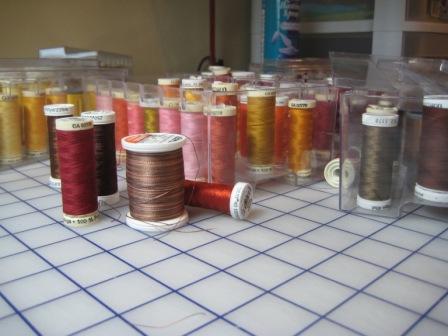 These days I’m just sewing every day. It’s dark, it’s cold, and the deadlines are fast approaching. Above you see my palette for drawing with stitch.
These days I’m just sewing every day. It’s dark, it’s cold, and the deadlines are fast approaching. Above you see my palette for drawing with stitch.
Here’s the second of five pieces I’m currently working on. Here it is held together with binder clips (I love binder clips!) so that I can check out the shape before I sew it together. In the detail you can see a dyed silk cocoon in the open space.
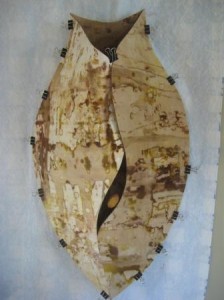
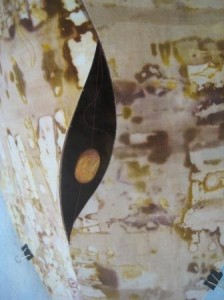
And here’s the piece partially assembled. Once finished, it’s off to the photographer!
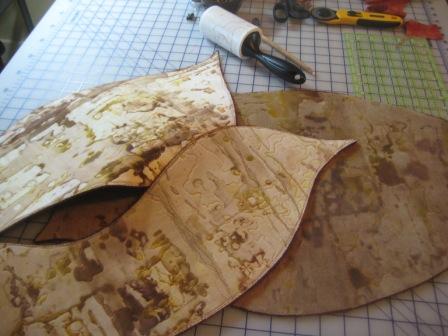
New Work for Foster White Show
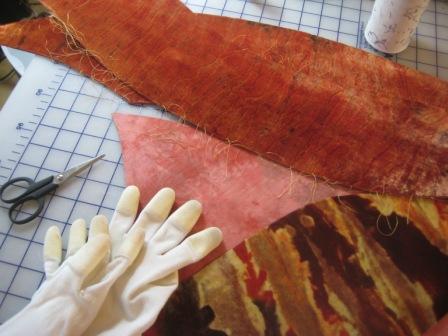 The work for the Foster White show is coming along. Although the show isn’t until February, I need to have all the work finished by the end of December! I’m on track but it has definitely been a push. Good thing I’m motivated by deadlines. I’ve got two pieces finished, and three in progress. My plan is get in the groove and have time to whip three more small free standing pieces done before the end of the year. Here are shots from the first piece in progress.
The work for the Foster White show is coming along. Although the show isn’t until February, I need to have all the work finished by the end of December! I’m on track but it has definitely been a push. Good thing I’m motivated by deadlines. I’ve got two pieces finished, and three in progress. My plan is get in the groove and have time to whip three more small free standing pieces done before the end of the year. Here are shots from the first piece in progress.
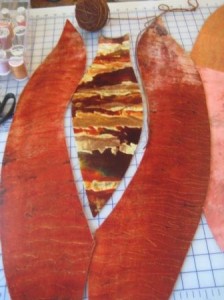
piece taking shape
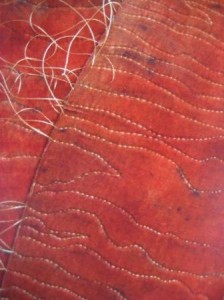
detail with stitching
Working with Resist
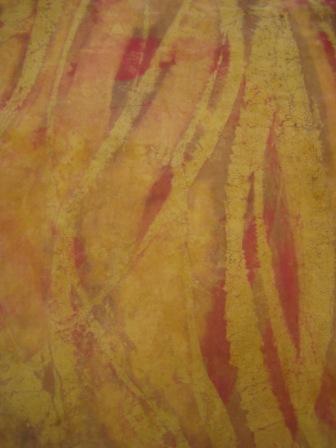
Flour and potato dextrin resists
Teaching informs my work in multiple ways. First, I get inspired by the students’ enthusiasm. I also usually have some time while the students are working to work. This unstructured time allows me to experiment without an agenda. My prep time also gets me to delve deeper into techniques. I’ll be teaching a workshop on using resists for surface design later this month at Pratt and it’s kept me in the studio, delving away and as a result, influencing the pieces I’m currently working on for the Foster White show in February. It’s kind of a chicken and egg sort of thing.
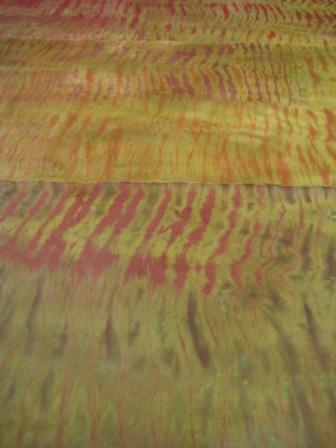
Three pole wrapped shibori pieces
I’ve been doing a lot more shibori work, dyeing, pole wrapping, discharging and then overdyeing. I’ve also been working with organic resists, flour and potato dextrin. The potato dextrin is tricky, sometimes it works, sometimes it doesn’t. I tried it a few weeks ago and it worked pretty well. The potato dextrin gives a really interesting, characteristic cracked earth looking effect. So I tried it again last week and it totally failed, and on some pretty big pieces of fabric, too. Instead of drying and cracking, it simply caked over and was white and floury. I decided to go ahead and over dye it anyway, figuring even if I didn’t get the full crackle effect I would get something. And I hated the idea of just washing it all out and starting over. I ended up with some pretty interesting fabric, not exactly what I’d planned, but when does that ever happen?
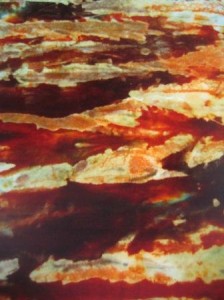
potato dextrin on velvet
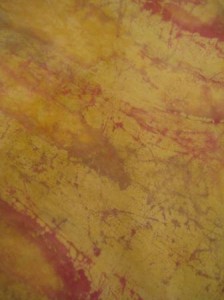
detail of flour and potato dextrin resist
